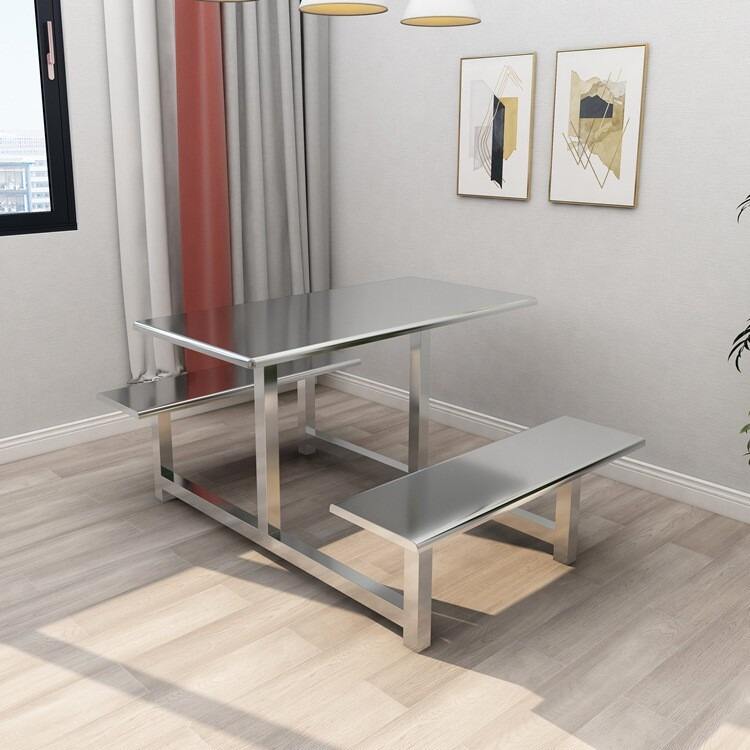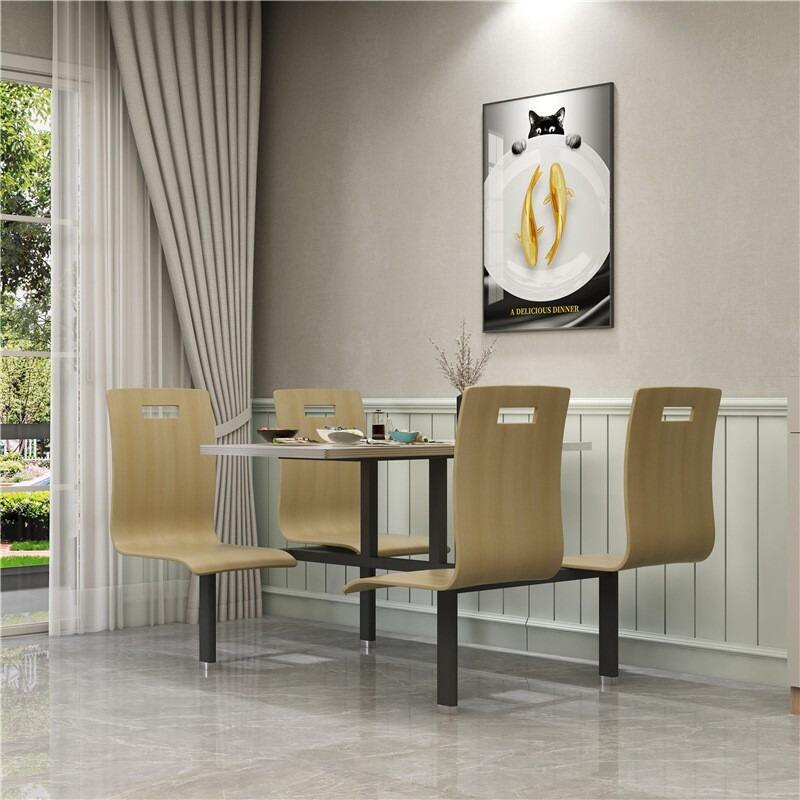Ինչպե՞ս ընտրել ճաշասենյակի սեղանի հավաքածու, որը համապատասխանում է ձեր ընտանիքի թվին և կենսակերպին
Ճաշասենյակի սեղանը միայն կահույքի մի կտոր չէ՝ այն տեղն է, որտեղ ընտանիքները հավաքվում են ճաշի, երեխաները տնային աշխատանքներ են անում, իսկ ընկերները խոսում են սուրճի մոտ: Ճիշտ ընտրված ընդունման սեղան հավաքածուն գտնելը նշանակում է գտնել մեկը, որը համապատասխանում է ձեր ընտանիքի չափին, ամենօրյա սովորություններին և տնտեսություն տարածքին: Անկախ նրանից, թե ձեզնից երկուսն են, մեծ ընտանիք եք երեխաներով, թե սիրում եք հյուրեր ընդունել, կա մեկը, ով ընդունման սեղան համապատասխանում է ձեր բոլոր պահանջներին: Եկեք քննարկենք, թե ինչպես ընտրել իդեալականը
1. Ընտրեք ճաշասենյակի սեղանի չափը ձեր ընտանիքի չափին համապատասխան
Առաջին քայլը սեղան ընտրելն է, որը բոլորի համար հարմար տեղ կապահովի: Խոան փոքր սեղանը կզգացվի խորան խորան, իսկ խորան մեծը կուղեցնի տարածքը
- Փոքր ընտանիքներ (2-4 հոգի) : Խորանի սեղանը լավագույնն է: Որոնեք 36-48 դյույմ (91-122 սմ) շրջանաձև կամ քառակուսի սեղաններ: Նրանք կտեղավորեն 4 մարդու առանց շատ տեղ զբաղեցնելու: Օրինակ, 42 դյույմ շրջանաձև սեղանը հարմար է փոքր խորանի համար, թողնելով բավականաչափ տեղ աթոռներ հետ քաշելու համար:
- Միջին ընտանիքներ (4-6 հոգի) : 60-72 դյույմ (152-183 սմ) ուղղանկյուն կամ էլիպսաձև սեղանը իդեալականն է: Այդ սեղանները բոլորին բավականաչափ տեղ են տալիս՝ առանց ծնկները բախվելու: 6 ոտնաչափ ուղղանկյուն սեղան 6 աթոռներով հարմար է մեծամասնության համար, տեղ թողնելով կենտրոնական կամ սպասքի համար:
- Մեծ ընտանիքներ (8+ հոգի) : Ընտրեք 84-96 դյույմ (213-244 սմ) ուղղանկյուն սեղան կամ փոքր սեղան ելույթներով: Ելույթներով սեղանները խելացի են՝ մնում են փոքր ամենօրյա օգտագործման համար, բայց ընդարձակվում են տեղավորելու 8-10 հոգու համար հյուրերի այցելությունների ժամանակ: Օրինակ, 6 հոգանոց սեղան 2 ելույթներով կարող է ձգվել տեղավորելու 10 հոգուն, հարմար տոների համար:
Լավ խորհուրդ. Սեղանի եւ պատի կամ այլ ապարանջանների միջեւ թող 11 սմ (91 դմ) տարածություն: Սա ապահովում է, որ բոլորը հեշտությամբ կարողանան շարժվել եւ հեռացնել աթոռները:
2. Ընտրեք նյութերը՝ կենցաղի ձեւը հաշվի առնելով
Ձեր ամենօրյա սովորությունները՝ ինչպես օրինակ երեխաներ ունենալը, հաճախ հյուրեր ընդունելը կամ պահպանման հեշտ ապարանջաններ նախընտրելը, պետք է ղեկավարեն ձեր սեղանի նյութի ընտրությունը:
- Տներ երեխաներով կամ կենդանիներով : Առաջնահերթություն տվեք ամուր եւ հեշտ մաքրվող նյութերին: Մաստուրբացիա եւ մաքրման մեխանիզմներ Քվարտզից կամ լամինատից պատրաստված սեղանների վրա նույնպես հիանալի է: Նրանք դիմացկուն են բծերի նկատմամբ (չկա ջերմության կամ սոուսի բծեր) եւ մաքրում են խոնավ կտորով: Խուսափեք ապակե կամ մարմարից, այստեղ մատնահետքեր են երեւում եւ հեշտությամբ քաշվում են:
- Հաճախ հյուրեր ընդունողներ : Կարևոր է ընտրել սեղան, որն աչքի է ընկնում հարմարավետությամբ և մաշվածության դիմաց դիմադրությամբ: Ծիրանի կամ նուռի փայտից պատրաստված սեղանը տալիս է տաքություն և ճաշակ, իսկ մարմարե թերթով սեղանը (պաշտպանիչ ծածկով) հարմար է կազմակերպված ընթրիքների համար: Ընտրեք սեղաններ հարթ եզրերով, որոնք հեշտ է մաքրել ընթրիքից հետո:
- Նվազագույն խնամքի կարիք ունեցողներ : Ընտրեք սեղան լամինատե կամ մետաղյա մակերեսով: Լամինատը գալիս է տարբեր ձևերով (նմանակելով փայտը կամ քարը) և գրեթե պահանջում է նվազագույն խնամք: Մետաղը (օրինակ՝ չժանգոտվող պողպատ) դիմացկուն է, դիմանում է թափված հեղուկներին և հարմար է ժամանակակից տների համար:
- Շրջակա միջավայրի նկատմամբ պատասխանատու ընտանիքներ : Ընտրեք սեղան վերամշակված փայտից կամ կայուն նյութերից (օրինակ՝ բամբուկ): Այս տարբերակները ամուր են և բարեկարգ են միջավայրի համար, համապատասխանում են թափոնների նվազեցման ձգտումներին:
3. Ընտրեք ձեր տարածքի և սովորույթներին համապատասխան ձև
Սեղանի ձևը կարևոր է, քանի որ այն որոշում է, թե ինչպես է այն տեղավորվում ձեր սենյակում և ինչպես է ձեր ընտանիքը այն օգտագործում:
- Ուղղանկյուն սեղաններ : Ամենատարածված ձևը, հիանալի է մեծ ընտանիքների կամ երկար, նեղ սենյակների համար: Դրանք հեշտ են տեղավորվում պատերի մոտ և թողնում են տեղ աթոռների համար երկու կողմերում: Կատարյալ է ընտանիքների համար, ովքեր ամենօրյա ճաշում են միասին՝ բոլորը ունեն իրենց «տեղը», իսկ մեջտեղում կա տեղ սպասքի համար:
- Շրջանաձև ճաշի սեղաններ : Լավագույնը փոքր տարածքների կամ ընտանիքների համար, ովքեր սիրում են խոսել: Շրջանաձև սեղանը չունի սուր անկյուններ, դա անվտանգ է երեխաների համար, և բոլորը կարող են տեսնել մեկը մյուսին (մեկ էլ մի ծայրում չի մնա): Լավ է քառակուսի սենյակներում կամ բաց խոհանոցային տարածքներում:
- Քառակուսի ճաշի սեղաններ : Նպատակահարմար է փոքր ընտանիքների համար (2-4 հոգի) քառակուսի սենյակներում: Նրանք հավասարակշռված և հարմարավետ են, հիանալի են ինտիմ ճաշերի համար: Կցեք երկարացման տերևներ, եթե երբեմն հյուրեր եք ընդունում:
- Սեղաններ ձվաձև : Ուղղանկյուն և շրջանաձևի խառնուրդ՝ տեղավորվում է ավելի շատ մարդ, քան շրջանաձև սեղանը, բայց ավելի փափուկ տեսք ունի, քան ուղղանկյունը: Լավ է նեղ սենյակների համար կորացված պատերով կամ ընտանիքների համար, ովքեր ցանկանում են յունիկ տեսք:
4. Հաշվի առեք ձեր կենցաղային կարիքները՝ գործառույթները կարևոր են
Մտածեք նաև սեղանի այլ հնարավորությունների մասին՝ բացի ճաշելու գործնական նպատակներից: Ամենօրյա կյանքը հեշտացնելու համար արդյոք ավելի շատ հնարավորություններ են անհրաժեշտ:
- Բազմախնդիր լուծողներ (տնային աշխատանքներ, աշխատանք, ձեռքի աշխատանքներ) : Շրջանաձև սեղանը, որն ունի հարթ մակերես և բավարար տեղ, ամենալավ տարբերակն է: 6 ոտնային ուղղանկյուն սեղանը թույլ է տալիս երեխաներին տարածել իրենց գրքերը, իսկ դուք կարող եք մեկ ծայրում տեղադրել մութ համակարգիչ: Որոնեք սեղաններ ամուր հիմքով (առանց ճոճվող ոտքերի), որոնք կարող են դիմանալ ծանր դասագրքերի կամ արվեստի պիտույքների ճնշմանը:
- Տնային տուն հրավիրողներ, ովքեր սիրում են մեծ ընկերություններին : Ընդարձակվող ճաշի սեղանը պարտադիր է: Փնտրեք սեղաններ թաքնված թերթերով, որոնք հեշտ է հանել՝ ավելորդ տեղ չզբաղեցնելու համար: Որոշ մոդելներ նույնիսկ ունեն ինքնատեղավորվող թերթեր, ուստի այն միշտ նուրբ է թվում անկախ նրանից, թե երբ է օգտագործվում: Զուգահեռ դրանք համադրեք կոճակավոր աթոռների հետ՝ ավելացված նստելու տեղերի համար, որոնք հեշտ է հեռացնել անհրաժեշտության դեպքում:
- Փոքր տարածքներ (բնակարաններ, փոքր տներ) : Տեղապահող կամ ծալովի ճաշի սեղանը տեղ է խնայում: Այդ սեղանները ծալվում են մինչև փոքր չափ (հարմար է պատի տակ տեղավորելու համար), իսկ անհրաժեշտության դեպքում ընդարձակվում են: Որոշ դեպքերում դրանք ծալված վիճակում նաև կարող են օգտագործվել որպես կոնսոլային սեղան՝ տեղի առավելագույն օգտագործում ապահովելու համար:

5. Ոճ. Ընտրեք ձեր տան ոճին համապատասխան
Չնայած գործառույթն ամենակարևոր բանն է, ճաշի սեղանի հավաքածուն պետք է համապատասխանի ձեր տնտեսություն -ի ոճին, որպեսզի տարածքը համակարգված տեսք ունենա:
- Ժամանակակից տներ : Լավ են հարթ գծերով և պարզ դիզայնով սեղանները: Ապակեպատ սեղանը մետաղյա ոտքերով կամ բաց գույնի փայտե սեղանը կամ կողմնային կանոնավոր եզրերով համապատասխանում է ժամանակակից ներքին տեսքին: Ավելացրեք աթոռներ չեզոք գունային նախատիպերով (սև, սպիտակ, գրանիտագույն)՝ համակարգված տեսք ստանալու համար:
- Շքեղ տներ : Այստեղ հարմար կլինեն տաք փայտի երանգները և դասական մանրամասները (օրինակ՝ կորացված ոտքերը): Նուռ կամ մահագունդի փայտից պատրաստված ճաշի սեղանը կամ կաշեպատ աթոռներով (բուրդ կամ մետաքս) կավելացնեն նրբությունը՝ առանց հնացած տեսք ունենալու:
- Գյուղական տներ : Վերամշակված փայտից պատրաստված ճաշի սեղանը հնացած վերջավորմամբ բերում է հյուրընկալության զգացում: Կողքին ավելացրեք փայտե աթոռներ կամ նստարաններ՝ սեղմ և հարմարավետ տեսք ստանալու համար:
- Ծովափնյա տներ : Լույս գույնի փայտ (օրինակ՝ կաղնի կամ եղևնի) կամ ճերմակ նստասրահային սեղաններ լավ են ստացվում: Ավելացրեք ամանցու նստականներ ունեցող աթոռներ (ռատան կամ ջուտ), որպեսզի պահպանեք լճային մթնոլորտը:
Հաճախ տրամադրվող հարցեր
Ինչպե՞ս չափել իմ տարածքը ճաշի սեղանի համար
Չափեք ձեր ճաշի տեղամասի երկարությունը և լայնությունը: Երկուսից էլ հանեք 36 դյույմ (91 սմ), որպեսզի ստանաք ճաշի սեղանի առավելագույն չափը: Օրինակ՝ 10x12 ոտնաչափ (120x144 դյույմ) սենյակում տեղավորվում է 84x108 դյույմ ճաշի սեղան:
Ի՞նչն է ավելի լավ՝ շրջանաձև թե ուղղանկյուն ճաշի սեղան երեխաներ ունեցող ընտանիքի համար
Շրջանաձև սեղանները ավելի անվտանգ են (երեխաները չեն կարող բախվել սուր անկյունների հետ) և խրախուսում են զրույցը: Ուղղանկյուն սեղանները կարող են տեղավորել ավելի շատ մարդկանց՝ ընտրեք ձեր ընտանիքի թվի և տարածքի հիման վրա:
Քանի՞ աթոռ պետք է գնեմ ճաշի սեղանի հետ
Գնեք ձեր ընտանիքի համար բավարար քանակով և 2 հատ ավելացնել հյուրերի համար: 4 հոգի կազմող ընտանիքը պետք է 6 աթոռ գնի, իսկ 6 հոգի կազմող ընտանիքը կարող է գնել 8 հատ: Այսպես դուք միշտ պատրաստ կլինեք անակնկալ հյուրերի համար:
Արդյոք մարմարե ճաշի սեղանը վատ ընտրություն է երեխաներ ունեցող ընտանիքների համար
Բնական մարմարը հեշտ է կորցնում իր տեսքը (հյութ, սոուս), սակայն ինժեներական մարմարը (քվարց) դիմացկուն է կորզումների նկատմամբ և հարմար է երեխաների համար: Այն նման է իրական մարմարին, բայց ավելի դիմացկուն է՝ հատկապես հարմար է մեծ ընտանիքների համար:
Կարո՞ղ եմ արդյոք խառնել և համապատասխանեցնել ճաշի սեղանի աթոռները իմ սեղանի հետ:
Այո՛: Այն մոդն է և գործնական է: Օրինակ, միացրեք փայտե ճաշի սեղան 4 աթոռների հետ (2-ը կտորով պատված, 2-ը փայտե) զվարճալի, ապարդյուն տեսքի համար: Ուղղակի պահպանեք գույները կամ նյութերը համապատասխան, որպեսզի խուսափեք հակասությունից:
Որքա՞ն պետք է ծախսեմ ճաշի սեղանի հավաքածուի վրա:
Գները տատանվում են $500 (բյուջեին համապատասխան հավաքածուներ) -ից մինչև $3,000+ (բարձր որակի փայտ կամ մարմար): Ներդրեք դիմացկուն սեղանի մեջ, եթե պլանավորում եք այն օգտագործել 10+ տարի ՝ ավելի էժան հավաքածուները կարող են ճկվել կամ կորզվել արագ:
Պե՞տք է ճաշի սեղանի վրա սեղանի փեշ դնել:
Ոչ, բայց այն կարող է պաշտպանել սեղանը (հատկապես փայտը կամ մարմարը) արատների և թափված հեղուկներից: Օգտագործեք լվացվող կտոր, հեշտ խնամքի համար, կամ բաց թողեք այն, եթե նախընտրում եք սեղանի բնական տեսքը:
Բովանդակության աղյուսակ
- Ինչպե՞ս ընտրել ճաշասենյակի սեղանի հավաքածու, որը համապատասխանում է ձեր ընտանիքի թվին և կենսակերպին
- 1. Ընտրեք ճաշասենյակի սեղանի չափը ձեր ընտանիքի չափին համապատասխան
- 2. Ընտրեք նյութերը՝ կենցաղի ձեւը հաշվի առնելով
- 3. Ընտրեք ձեր տարածքի և սովորույթներին համապատասխան ձև
- 4. Հաշվի առեք ձեր կենցաղային կարիքները՝ գործառույթները կարևոր են
- 5. Ոճ. Ընտրեք ձեր տան ոճին համապատասխան
-
Հաճախ տրամադրվող հարցեր
- Ինչպե՞ս չափել իմ տարածքը ճաշի սեղանի համար
- Ի՞նչն է ավելի լավ՝ շրջանաձև թե ուղղանկյուն ճաշի սեղան երեխաներ ունեցող ընտանիքի համար
- Քանի՞ աթոռ պետք է գնեմ ճաշի սեղանի հետ
- Արդյոք մարմարե ճաշի սեղանը վատ ընտրություն է երեխաներ ունեցող ընտանիքների համար
- Կարո՞ղ եմ արդյոք խառնել և համապատասխանեցնել ճաշի սեղանի աթոռները իմ սեղանի հետ:
- Որքա՞ն պետք է ծախսեմ ճաշի սեղանի հավաքածուի վրա:
- Պե՞տք է ճաշի սեղանի վրա սեղանի փեշ դնել:


